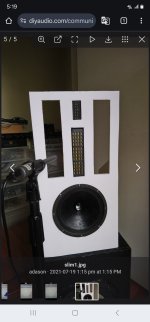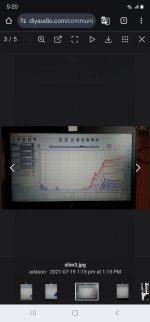I have used tiny dayton dome in top of 4way, they are cheap and perform reasonably well.I am planning a 4 way build. A little bit of an unconventional one (like always with me)
I am looking for a really small dome tweeter. The idea is to get a really like spread of sound throughout the room and the smaller the tweeter, the higher the frequency it falls off. At least, that's how I currently understand it. Feel free to correct me.
I am looking at this Peerless unit and wonder if there are any other small diameter dome tweeters I should be looking at.
https://www.parts-express.com/Peerless-D19TD05-08-3-4-Poly-Dome-Tweeter-264-500?quantity=1
View attachment 1444467
Just for reference, the idea here is to match the octave to the size for proper spread.
8-10" woofer 35-350hz
200-1000hz - 6.5-7" woofer
750-5000hz - 2-3" dome mid
4000 - 20khz - Small diameter dome tweeter.
I believe the diameter of the driver plays a very large role in when the frequency response starts to drop concerning off-axis. Here you see this very tiny tweeter doesn't drop off axis until around 9000hz. So if I stay within the proper octave of the diameter of driver I can basically have an even spread across the room and it won't matter where I happen to sit.
If you have a recomendation of a small tweeter, I would like to hear it. Thanks
Another small dome which performs very well with low distortion is hiquphon. Not cheap.
However, recently for 4way, i was putting small foster planar on top. Great flat response to 40kHz, flat impedance, great dispersion, low distortion. Cheap, was on sale.
Foster e100t10 planar does not seem to be available, but there was plenty from other sources.
https://www.parts-express.com/Foster-E100T10-Ribbon-Tweeter-8-Ohm-279-468
https://www.parts-express.com/Foster-E100T10-Ribbon-Tweeter-8-Ohm-279-468
Attachments
I believe Buchardt S400 actually chose the 19mm dome, because it "loaded" the waveguide better, since a soft dome tend to have a taller structure to support its shape, even though it's made from soft material.
Hi there,
if you are looking for less small directivity plot at very high frequencies there are some old designs with an acoustic lens placed in front of the larger dome that can achieve the same as the dome with 19mm diameter or even less where you have to find the right way to couple the super tweeter to the mid range dome
Scan Speak D2904-980000
https://www.scan-speak.dk/datasheet/pdf/d2904-980000.pdf
Visaton KE25SC
https://www.visaton.de/en/products/drivers/dome-tweeters/ke-25-sc-8-ohm
https://www.visaton.de/sites/default/files/dd_product/KE 25 SC_0.pdf
another option could be to couple a small ribbon tweeter with a larger dome tweeter like DALI is doing with a couple of floor standers
https://www.dali-speakers.com/en-gb...ing/?placement=floorstanding&category=passive
hope it helps, Stefano
if you are looking for less small directivity plot at very high frequencies there are some old designs with an acoustic lens placed in front of the larger dome that can achieve the same as the dome with 19mm diameter or even less where you have to find the right way to couple the super tweeter to the mid range dome
Scan Speak D2904-980000
https://www.scan-speak.dk/datasheet/pdf/d2904-980000.pdf
Visaton KE25SC
https://www.visaton.de/en/products/drivers/dome-tweeters/ke-25-sc-8-ohm
https://www.visaton.de/sites/default/files/dd_product/KE 25 SC_0.pdf
another option could be to couple a small ribbon tweeter with a larger dome tweeter like DALI is doing with a couple of floor standers
https://www.dali-speakers.com/en-gb...ing/?placement=floorstanding&category=passive
hope it helps, Stefano
Last edited:
one additional comment after the edit timeout for the last post
it may be interesting to take a look what the pro's are doing with their mid field high SPL monitors like this one
https://atc.audio/professional/loudspeakers/scm100asl-pro/
crossover 3500 Hz between 75mm mid range dome and 25mm dome tweeter
i know only the simulation program from Visaton Boxsim that visualize also the simulation of the directivity graph
this graph need to be in a small limit of variation between +/- 3dB for a good directivity plot
playing around with a 4 way design in Visaton Boxsim with the small 20mm tweeter i can see that even with a small 3.5 inch cone for high mid range you can achieve only a decent directivity graph with a M T M placement, beside the fact that with one small 3.5 inch cone the max SPL is too low
of course with the 3 inch mid range dome the max SPL is much better, but the coupling problem to a small tweeter with a discontinuity in the directivity graph in the crossover region is still a problem
https://www.adam-audio.com/blog/understanding-speaker-directivity-charts/
it may be interesting to take a look what the pro's are doing with their mid field high SPL monitors like this one
https://atc.audio/professional/loudspeakers/scm100asl-pro/
crossover 3500 Hz between 75mm mid range dome and 25mm dome tweeter
i know only the simulation program from Visaton Boxsim that visualize also the simulation of the directivity graph
this graph need to be in a small limit of variation between +/- 3dB for a good directivity plot
playing around with a 4 way design in Visaton Boxsim with the small 20mm tweeter i can see that even with a small 3.5 inch cone for high mid range you can achieve only a decent directivity graph with a M T M placement, beside the fact that with one small 3.5 inch cone the max SPL is too low
of course with the 3 inch mid range dome the max SPL is much better, but the coupling problem to a small tweeter with a discontinuity in the directivity graph in the crossover region is still a problem
https://www.adam-audio.com/blog/understanding-speaker-directivity-charts/
Last edited:
You sim whole system at once, so by muting or turning on you can readily see difference between 1, 2 or 3 drivers and driver placement.Can you dim multiple driver diffraction at once?
Here one can see how floor/ceiling bounce improves when one bass driver is moved down to the floor instead of being higher up like in a classic MTM.
I've still got a couple of those small Foster tweeters in the stash. Seems they are best used above 10kHz.
Yeah I've noticed the material doesn't seem to matter a ton compared to comes.Bit of an old myth. Most metal dome break up is outside of the audible range. Soft domes are what typically exhibit break up in the audible range. It's a little silly to pick a tweeter based on it's diaphragm material anymore. The sound of a tweeter mostly comes from how it's integrated.
What is strange to me is the off axis responses vary WILDLY of domes the same diameter. Do you know what is design feature that most impacts off axis response of a dome? Is is the radius?
Looks like I have a bit of learning to do. Are there any more in depth tutorials on how to use the tools and its features or just the manual? You care if I PM you and ask you questions as I figure this out?You sim whole system at once, so by muting or turning on you can readily see difference between 1, 2 or 3 drivers and driver placement.
Yup. I used 9k for this project. Here is just development stage.I've still got a couple of those small Foster tweeters in the stash. Seems they are best used above 10kHz.
Attachments
Radius is one aspect.Yeah I've noticed the material doesn't seem to matter a ton compared to comes.
What is strange to me is the off axis responses vary WILDLY of domes the same diameter. Do you know what is design feature that most impacts off axis response of a dome? Is is the radius?
The "height" of a dome can change it - flatter is wider. Inverted has an effect; in essence it's like a dish cone.
Size of surround can affect things as it is a radiating area and starts being a waveguide if it gets large.
Material can affect dispersion as some are rigid and others can bend.
The small "waveguide" that goes unnoticed that's built into almost all dome tweeters can affect the response; someone on ASR simulated a few of these
In addition to this there are phase guides and other things placed in front of a dome; eg most recently, the Purifi tweeter , but has been done in some ways for decades
Totally OK, ask away.You care if I PM you and ask you questions as I figure this out?
Do you have a link to this? I'd love to look at what was done to get the dispersion Purifi claimssomeone on ASR simulated a few of these
In addition to this there are phase guides and other things placed in front of a dome; eg most recently, the Purifi tweeter , but has been done in some ways for decades
My two thoughts are:
1. There are excellent 1" dome tweeters as well.
2. If your interest is in excellent off-axis response you need to be prepared to sweat the crossover details, especially if you want excellent vertical performance as well. This is an area where most passive speakers do poorly at, especially above the tweeter axis. If you want this to go well you probably want higher order filters. Point is just, if you must have a 4-way and you are looking for excellent dispersion don't rush the crossover. You may also want to spend a little more to get parts that perform exceptionally smoothly outside their target ranges to minimize crossover complexity.
It's all good fun though, looking forward to seeing what you do.
1. There are excellent 1" dome tweeters as well.
2. If your interest is in excellent off-axis response you need to be prepared to sweat the crossover details, especially if you want excellent vertical performance as well. This is an area where most passive speakers do poorly at, especially above the tweeter axis. If you want this to go well you probably want higher order filters. Point is just, if you must have a 4-way and you are looking for excellent dispersion don't rush the crossover. You may also want to spend a little more to get parts that perform exceptionally smoothly outside their target ranges to minimize crossover complexity.
It's all good fun though, looking forward to seeing what you do.
For the Purifi, some stuff on their site : https://purifi-audio.com/blogDo you have a link to this? I'd love to look at what was done to get the dispersion Purifi claims
There may be some discussion in the Purifi spk16 thread on there too.
Tweeter front plate design thread : https://www.audiosciencereview.com/...weeter-front-plate-design.46155/#post-1683161
Has some interesting tests including having non perfect rebate fitment etc
- Home
- Loudspeakers
- Multi-Way
- Small Diameter Dome Tweeters


